A mashup of ideas from David Deutsch, Geoffrey Miller, and Richard Prum, with a little César Hidalgo for good measure.
Of all the problems that can plague a discussion of beauty — and there are several — perhaps the most damning is how to define the word, to find a sturdy concept worthy of the label.
Look no further than the debates over whether beauty is “objective” or “subjective.” Is it out there in the world, or in here in our minds? When we can’t agree on this most fundamental distinction, we're not talking about the same thing.
I’ve been mulling over the idea of beauty recently, letting the word glide around over many possible meanings. It took a while, but I finally found one that clicked. Unlike the other meanings I’ve toyed with, this one is tangible and solid; it keeps its shape. I’ve had a lot of fun playing around with it, and I’m going to share it with you today.
But please, understand that I’m not trying to annex the word, to repurpose it to point toward my preferred concept. I don’t particularly care what other people mean when they talk about “beauty”; I have no dog in that fight. I just want to describe something that happens in the world, something I think is fascinating. And the best label I can think to give it is “beauty.”
Are you with me?
Here’s a little preview of where we’re headed: I want to talk about beauty as a game. Specifically, a two-player game. Or to be maximally precise: a family of games with two main player classes.
It will make sense soon, I promise.
In the meantime, please leave your semantic baggage at home, put on your Quinean naturalist’s hat (ideally with a bright feather in it), and let’s head out on a little armchair safari.
Desire
As a way of approaching this thing we want to talk about — “beauty” — we’ll begin with a simpler phenomenon. Whenever a creature observes something, gets a good feeling, and is attracted to it, let’s call that desire.
The phenomenon of desire — attraction mediated by perception — describes many of the basic low-level instincts that animals have. So we can speak of the desire for food and the desire for sex, to give some paradigmatic examples. But we can also say that mother animals desire their children, and vice versa. Or that a squirrel, looking up at a nice perch, desires it as a place to rest.
For our purposes today, no special cognitive complexity or inner experience is required. Even a lowly insect can be the subject of desire — as a dragonfly toward its mate, for example, or a dung beetle toward a piece of dung.
It’s not hard to see how desires like these can be adaptive, i.e., the kinds of features sculpted by natural selection. We can even see this in our own species. Smooth skin is a sign of good health, whereas boiling skin is a sign of disease, and so we evolved to desire the former and be disgusted by the latter. A ripe strawberry is nutritious, whereas deer droppings are not, and desire helps us choose between them. One of these landscapes is better suited for humans — and which are you drawn toward?

Not every desire is adaptive, of course; our sensibilities often lead us astray. But that’s what desire is for, that’s its purpose: to guide us toward what’s typically good for us.
So this is our first game. It’s a game of solitaire, played by a creature (whom we’ll call Desire) against a mostly static environment. The Desire player’s goal is to learn which features of the environment are good and should therefore be approached, and which features are bad and should therefore be avoided:
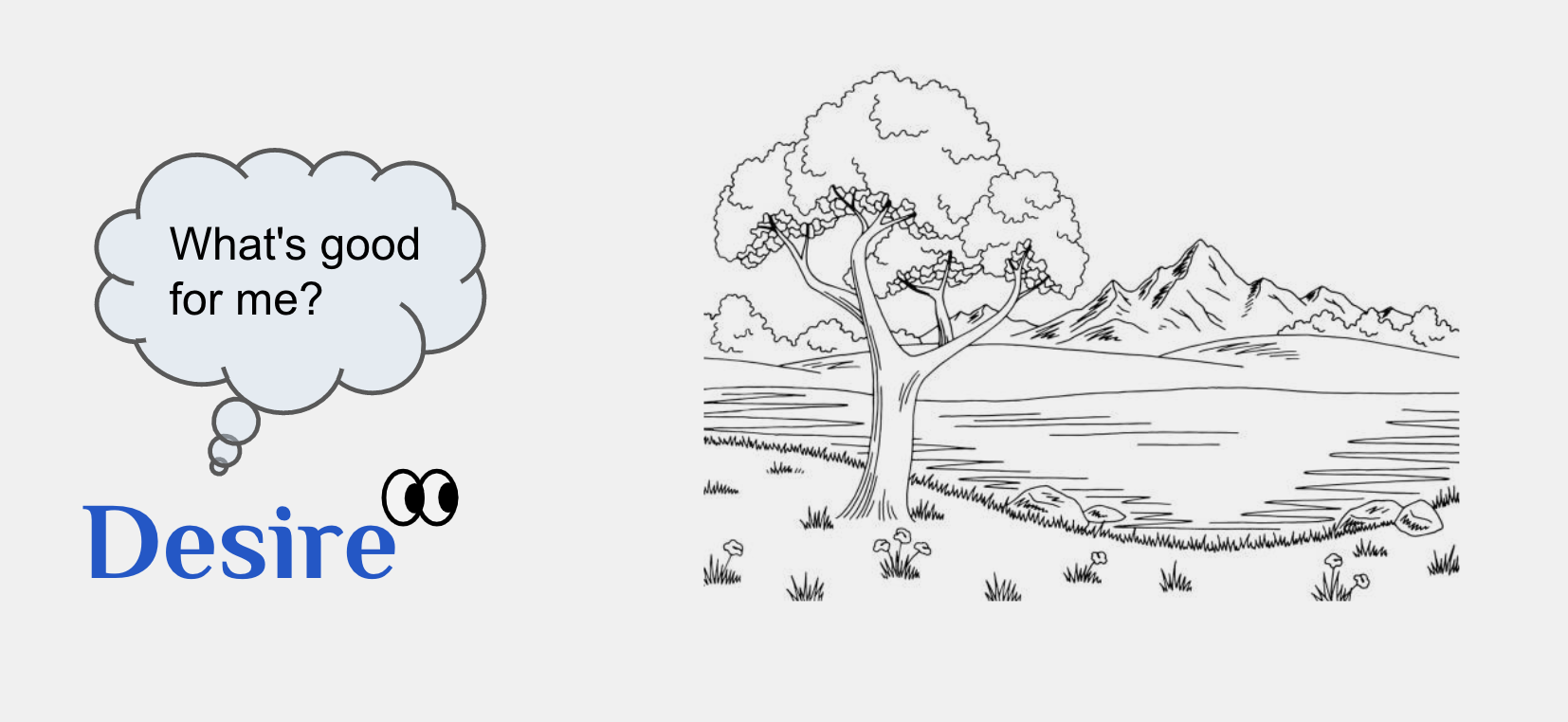
Sometimes Desire learns with its brain, as an individual creature within its own lifetime. But often the player’s brain isn’t flexible enough, so the learning takes place in the species’ genome via natural selection; in that case, the player is actually the entire species. Either way, Desire eventually learns what to approach and what to avoid.
Now we could stop here and declare that beauty = whatever triggers good feelings in a Desire player. This would be a perfectly sensible definition: if something appeals to you, it’s beautiful, end of story. This is the kind of beauty that people say is “in the eye of the beholder,” where each creature develops its own subjective tastes. The dung beetle can find dung “beautiful” while we find it disgusting, and there's no tension whatever between these two facts.
This definition of beauty would make a fine concept — if we were diligent about hewing to it. It’s just that games of solitaire are boring, so the word we’re attempting to pin down keeps slipping off for more exciting meanings, for denotations with sexier connotations.
Specifically, it’s when a second player enters the field — a player who produces something deliberately to attract the Desire player — that things really start to heat up.
Player Two
By way of introducing the second player, consider this brief visual history of plant life on Earth. We’ll start with the earliest single-celled organisms and work our way down to plant species in the present day.
So, Earth is 4.5 billion years old. And for the first 500 million years or so, it could reasonably be described as “just a bunch of rocks and water”:

(Please don’t fret over whether these photos are historically accurate — they aren’t. Just focus on the gestalt impression they make.)
Sometime around 4 billion years ago, the first single-celled lifeforms emerged. Here they are accreting into a so-called “microbial mat”:
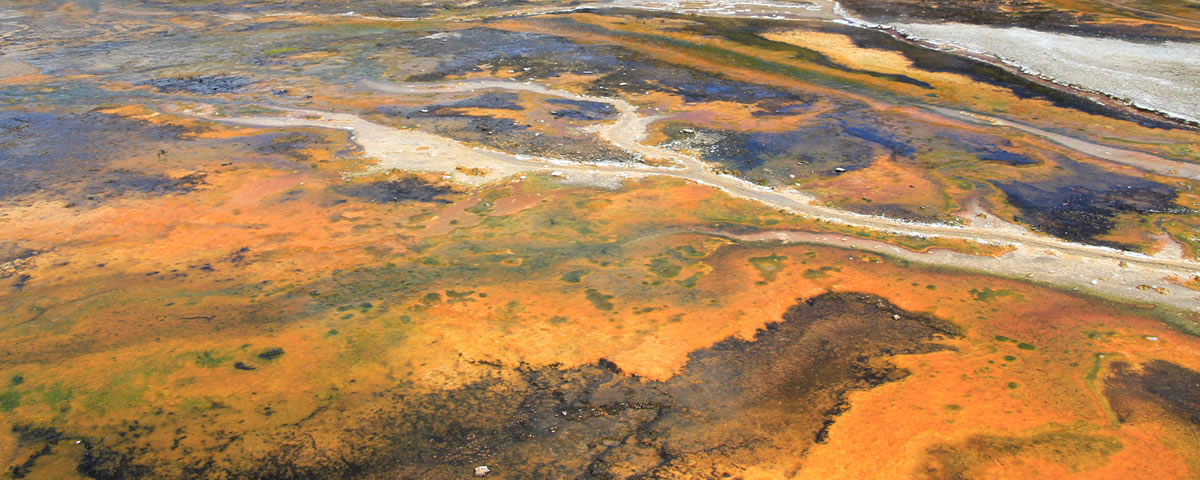
A good while later, around 1.5 billion years ago, green algae arose. This is the proverbial “pond scum”:

Then, around 500 million years ago, plants begin to colonize the land:
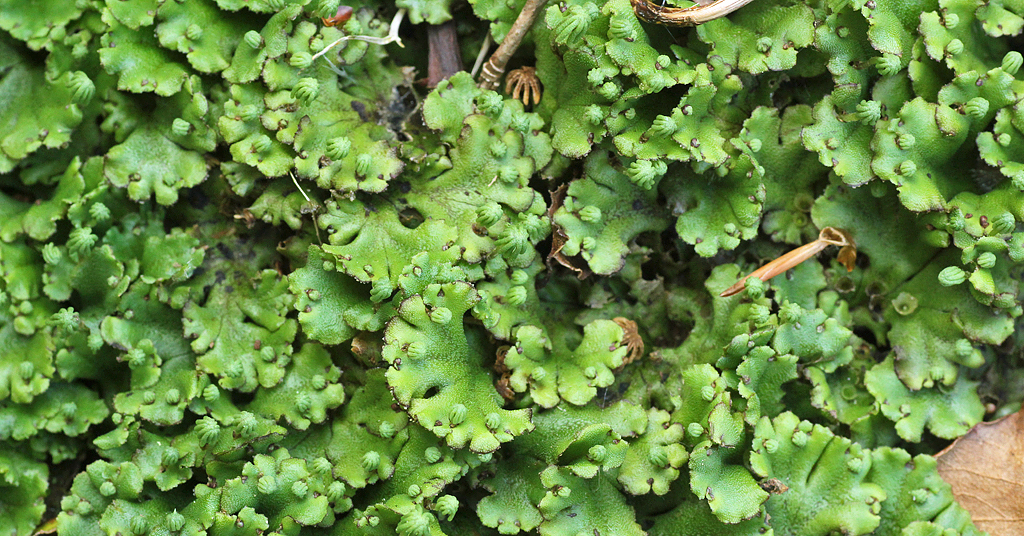
But these plants lacked vasculature and had to live very low to the ground (think mosses). It wasn’t until 400 million years ago that plants like ferns developed stems and shot up into the sky:

Now pause with me for a moment to note the narrow color palette.
For most of its history, plant life on Earth has been characterized by greens and browns. Green, because that’s the color of chlorophyll. And brown, because that’s the color you get when you mix too many paints together — the color of accident.

So that’s what the plant kingdom looked like for most of its history.
... until approximately 130 million years ago, when suddenly this happened:
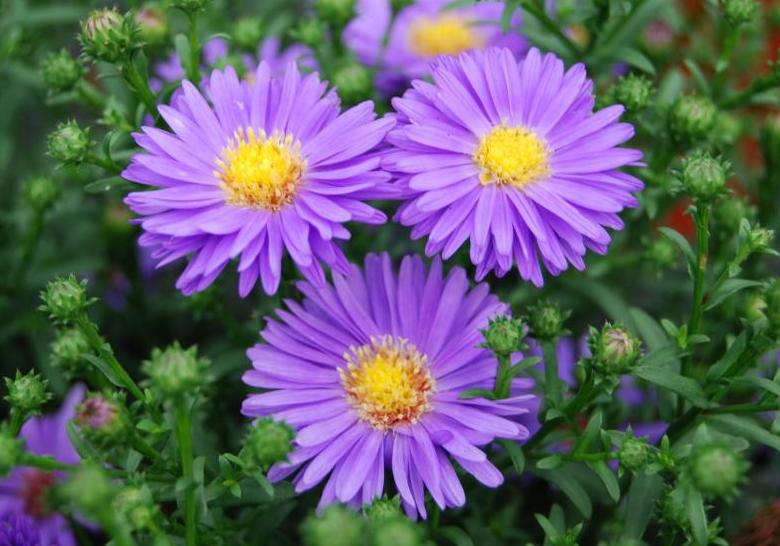
Please take a moment to be astonished by this image.
If you’d like — and I can’t recommend against it — take a moment to get high and then be astonished by the image.
In the meantime, some more flowers:
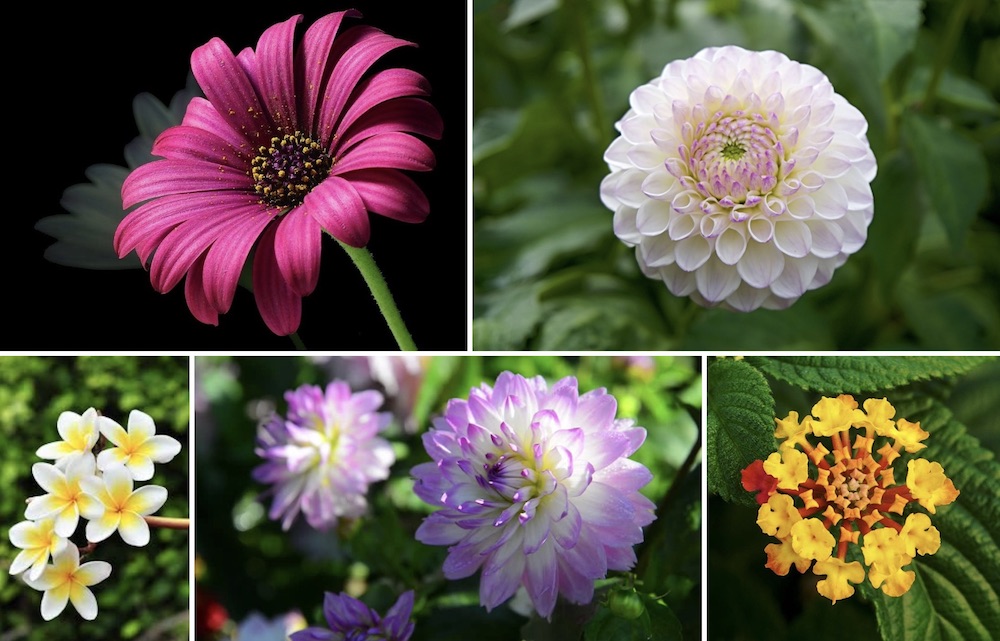
It’s easy to take flowers for granted, in part because they’re so familiar; we’ve known them since we were two feet tall. But when we step back and take the long view, we can see that they’re a dramatic departure from previous forms of plant life. Where everything else is drab and boring, a flower is bold and showy. While other plant organs are strictly utilitarian, a flower goes out of its way to be noticed. It’s a bid for visual attention in a world that’s otherwise oblivious to the gaze of others.
This is player two, AKA the Beauty player:

And of course, Beauty can only be understood in tandem with Desire, the player experiencing the attraction:

We all know what flowers are up to: they’re a plant’s way of having sex. For fertilization, a plant needs to get its pollen (i.e., plant sperm) over to another plant of the same species. Before flowers, plants did this by releasing their pollen in water or on the wind, hoping it would land in the right place. But this is a scattershot approach, error-prone and exceptionally wasteful. The genius of flowering plants was figuring out how to move pollen precisely and reliably by recruiting animals as their couriers. These are our Desire players, and in the context of flowering plants, they’re called pollinators. The most iconic pollinator, of course, is the honeybee. But the role can be filled by many other insects (like butterflies), as well as birds (hummingbirds) and even mammals (bats).
This relationship is simple, but also profound. The plant lures the pollinator with the promise of food (e.g., nectar). And when a plant consistently delivers on its promise, the pollinator keeps coming back. Not just to the very same plant, but to other plant of the same species, thus ensuring an extremely high fertilization efficiency.¹ And the flower mediates this relationship by acting as a brand image. Its distinctive shape and arresting colors are a mnemonic to remind pollinators of the plant’s good faith and credit. “Get your sweet nectar here!” the flower calls out, “And wherever else you see our trademarked signs!”
Thus the flower’s beauty isn’t capricious. It’s a solution to a very concrete problem.
And what a solution it turned out to be! Since bursting on the scene some 130 million years ago, flowering plants have completely taken over from their predecessors, such that they now dominate the landscape. It’s estimated that flowering plants make up 90 percent of all plant species and more than half of all biomass on Earth.² That’s the power of beauty.
A game for two players
Here, then, is our game. It’s played between two player types, Desire (P1) and Beauty (P2).
The essence of the game is simple: the Desire player makes a free choice, based on perceptual cues, about what to approach and what to avoid, while the Beauty player strives to attract the Desire player by performing or producing something:

Note that the Desire player here is more or less identical to the Desire player in the game of solitaire we described earlier. In both games, Desire’s goal is to learn which perceptual cues are good vs. bad. So as the bee buzzes around, it uses its aesthetic sense to decide where to land — and when it sees something that tickles its brain in the right way, it flies toward it. But the bee doesn’t particularly care that the flower was made by an adaptive Beauty player. If nectar started bubbling up from the ground, the bee would be just as happy, and would soon develop a preference for cracks and fissures rather than flowers.
The Beauty player, however, can’t play solitaire. The whole point of Beauty is to make something Desire wants, to trigger the oooh-circuits in Desire’s brain. Without Desire, there’d be no audience for Beauty’s performance, and no reason for it to make anything beautiful.
The metaphor of lock and key might be helpful here. Desire’s brain acts like a lock, and only certain perceptual cues will fit the lock and engage the attraction response. Beauty, then, has to produce something that works as a key:

But whereas a physical lock-and-key system is engineered all at once, Desire and Beauty coevolve slowly. Their dance goes something like this:
- The Desire player starts by playing solitaire, and evolves perceptual preferences that help in its environment. For example, an insect might develop a slight attraction to round shapes and/or bright colors (for reasons that have nothing to do with flowers).
- A nascent Beauty player then evolves a form to deliberately target those preferences — a key that fits Desire’s lock. At first the form will only work as a weak trigger, but over time Beauty will learn to make stronger and stronger stimuli, like brighter colors and more symmetrical petals.
- Meanwhile, as long as the Beauty player continues to reward the Desire player (e.g., by feeding it nectar), then Desire will develop an even stronger preference for the relevant stimuli. What was initially just a slight bias will become a fixation.
- If this relationship is fruitful, other Beauty players will inevitably try to get in on the action. And thus each Beauty player will need to outcompete its rivals by producing something that works as an even stronger trigger to the Desire player.
And so on. This positive feedback loop — Desire chasing Beauty in realtime and Beauty chasing Desire over evolutionary time — is what drives the production of beauty in every nook and cranny of the natural world:
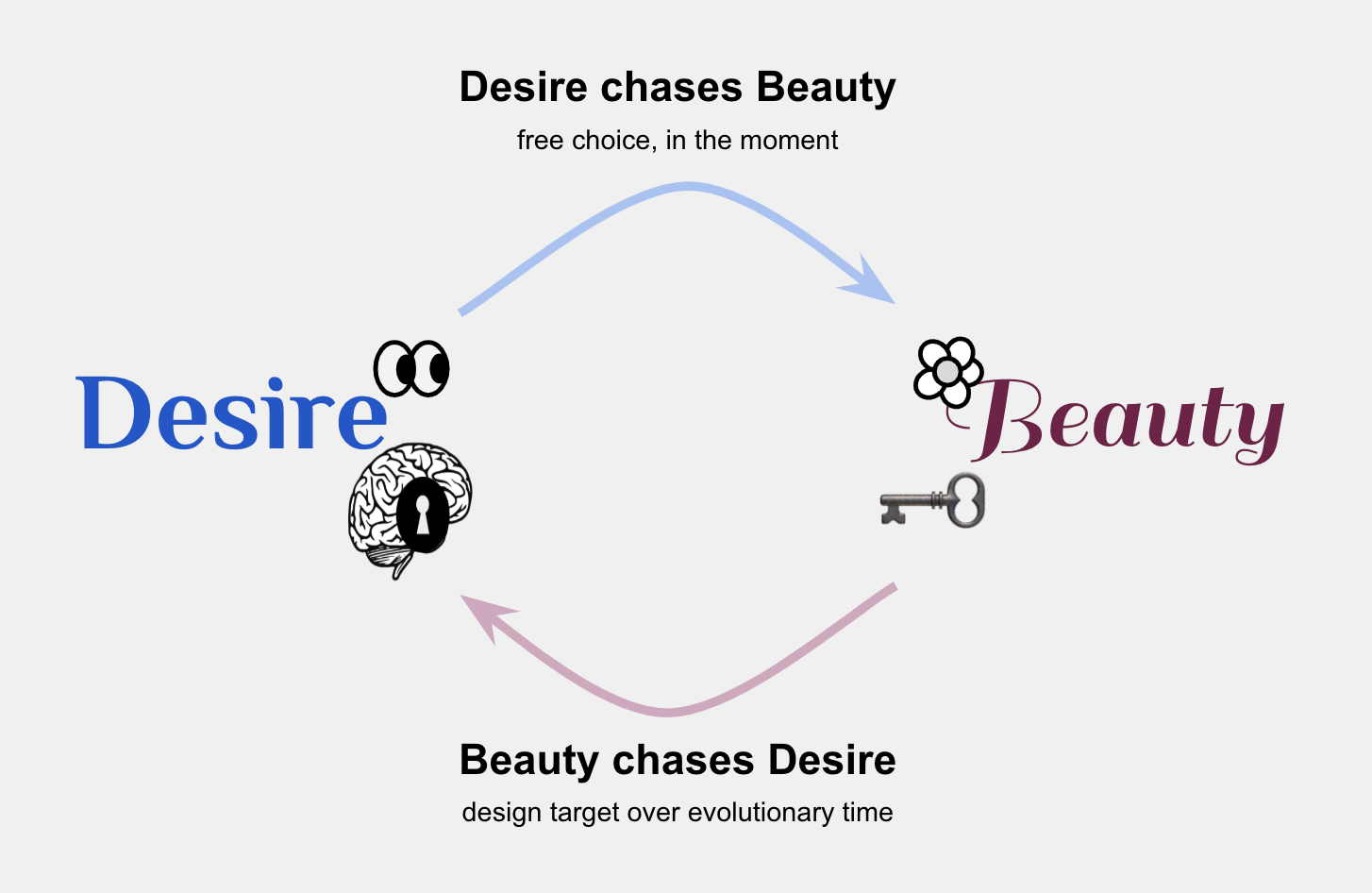
Please note: This is not a Grand Unified Theory of beauty. There are many important questions not addressed by this framing — for example, questions about taste and class, or which forms of beauty are sublime vs. merely kitsch. The idea of beauty-as-game will happily endorse both a Rembrandt and a Thomas Kinkade as “beautiful” — and if that’s a problem, you’ll have to seek distinctions elsewhere. Instead, the perspective offered here will help answer questions like Why does beauty grow? and Under what conditions is beauty stable? Or even, How will beauty behave on other planets?
It’s about, in Sarah Perry’s phrase, the ecology of beauty.
Of course, no two beauty games are identical. They’re played in different media and different environments, and the economic relationships between the players can differ wildly from game to game. But there’s enough in common across all games that they’re worth examining together; they constitute a family. And that’s what we’re here to study.
Two-player beauty in animals
Now when I mentioned flowers earlier, I may have given the impression that they were the first Beauty players on Earth. Actually they're just the first in the plant kingdom. Whereas animals have been playing Beauty with other animals for quite a bit longer — maybe 300 million years longer, give or take.
When animals play beauty with each other, they almost always do it in the context of sexual selection, that is, in the competition for mates. Sexual selection typically occurs in polygynous species, where the males compete for opportunities to mate with the females. This kind of competition doesn’t always produce beauty; often it results in raw male-on-male aggression. But in species where it’s harder for males to dominate the females — i.e., when females have more choice — males must compete to attract potential mates. In other words, males play Beauty and females play Desire.
(Whether this pattern applies to the human animal, we’ll discuss below. But it’s a strong pattern across the planet, and the rare exceptions serve to illustrate the general rule.)
In terms of beauty, sexual selection driven by female choice tends to produce some spectacular results. It’s how we get the bright scales of the cichlid, the elaborate underwater nests of a pufferfish, and the painted face and butt of the mandrill:

Perhaps most famously, sexual selection is how we get the train of the peacock. But it’s also how we get the plumage of almost any flamboyant bird, as well as the flap on a peacock spider:

And let's not forget the decked-out bachelor pads of the bowerbird. These may not be especially beautiful by human standards, but they’re the closest thing to deliberate art found outside our species:
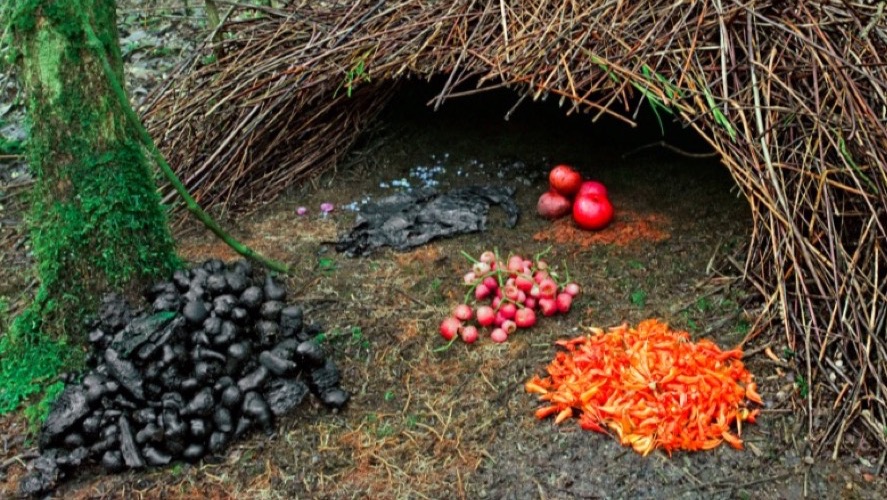
Again, in the animal kingdom, most of these feats of beauty are made by the male in order to win the freely-conferred affections of a female.
Note that the examples I’m providing here are forms of static visual beauty. That’s what’s easy to show on a web page. But it leaves out all the songs, dances, smells, and other attributes and behaviors that can’t be rendered as JPEGs. These forms of beauty are just as important to animals and are equally shaped by sexual selection. And the process is similar: preexisting perceptual biases in the female (Desire) player become an evolutionary target for the male (Beauty) player. For instance, a slight preference for certain sounds in the female nightingale’s auditory cortex is what induces the male nightingale to evolve its famous songs.
The media may be different, but the mechanics are the same. Within a given generation, female Desire players chase male Beauty players. But across generations, male traits evolve to target female preferences.
Human beauty games
But what about us? Do we also play beauty as a kind of mating dance?
We are animals, after all. And so it’s not surprising that we can pattern-match some of our activities to sexual selection driven by female choice. But it seems just as often to go the other way around, where women compete as the Beauty players vis-à-vis male Desire.
Sexual selection does sometimes occur in a monogamous species (ours being more or less deserving of the label). In such cases, males and females play both roles, Desire and Beauty; each makes a display for the other to admire and choose. Hence the ornaments and the eye for ornament among both sexes in the black swan and the crested auklet. And perhaps in our species as well.
But try as we might to pin a mating agenda on all human beauty production, it doesn’t always fit. Heterosexual men enjoy beautiful things made by other men, just as women enjoy performing for other women.³ Even very young children have an aesthetic sense. All in all, we spend too much effort producing and appreciating beauty outside of mating contexts:

Again, these are just a few forms of beauty that can be appreciated as static visuals. Other forms include songs, dances, poetry, novels, and pretty much any other thing that’s considered an art form. A few forms that are less often referred to as “beautiful” (but still, I think, fit the bill) include perfumes, Swedish massages, and elegant mathematical proofs.
So if not sexual selection alone, what occasions all these varied and refined forms of beauty in our species?
I’ve thought about this quite a bit over the years. And increasingly I’m convinced that much of what makes humans unique — including our taste in beauty — is our hunger for prestige.
I’ve written a lot about prestige status in the past, so I don’t want to belabor the point for long-time readers. But allow me a few words, briefly, to get us all on the same page.
Prestige is a form of social status, and the best way to understand it is to contrast it with dominance. Together, these two phenomena make up most of what we think of as social status. Dominance is based on fear (who can hurt me?), whereas prestige is based on attraction (who can help me?). Dominance, of course, is found throughout the animal kingdom: alpha males, pecking orders, hierarchies, etc. Prestige is a bit harder to spot, but tends to arise in species that coordinate their efforts in small groups — for example, wolves, lions, meerkats, and birds like the Arabian babbler. But no one does prestige like Homo sapiens. For reasons that are out of scope for this essay, human life allows enormous returns to cooperation, unprecedented (apart from the social insects) in the animal kingdom. And much of this cooperation is mediated by prestige.
Here’s what’s important for beauty: Prestige — like pollination and sexual selection — is a game of attraction in which Beauty players compete to attract free-choosing Desire players. Just as the flower blooms for the bee, and just as a peacock angles for the eye of the peahen, so do humans compete for the attentions and affections of our peers. And just as this game produces incredible ornaments in petals and feathers, so does it yield spectacular results in the media we control:

This is one reason we tend to find so much beauty in contexts governed by prestige, e.g., in museums, galleries, temples, palaces, and monuments, as well as in our homes (architecture, decor) and on our persons (body art, fashion). Even money — a distillation of prestige — probably evolved out of objects, like seashells and shiny metals, collected in part for their beauty.
By way of an archetype, consider a powerful nobleman in feudal Europe, circa 1500, trying to govern his lands and expand his influence. On the one hand (dominance), he’ll want to strike an imposing figure, both in the way he carries himself and in his projected presence. But no man rules by dominance alone; every leader finds use for the carrot as well as the stick. So on the other hand (prestige), our feudal lord will also benefit by putting his friendlier qualities on display.
Consider, in particular, the nobleman’s dining hall. Here he will host a variety of guests, all of whom he might hope to influence in some way. And the more time they spend in his venue (rather than, say, dining with his rivals), the more favor he’ll be able to curry. But all of his guests have other choices for where to spend their time, so he must provide a venue that people positively enjoy. And one of the best strategies here is to make and display beauty. The food and drink, of course, must be exquisite. But he’ll also commission rich tapestries for the walls and elegant chandeliers for the ceiling. Perhaps he’ll even hire musicians and dancers to entertain people before and after the meal. His guests are like honeybees, so he must be like a flower.
Pop Quiz
We’ve now seen how three entirely different ecologies — plant fertilization, sexual selection, and prestige status — give rise to games of multiplayer beauty. I hope these have given you an intuitive grasp of the phenomena in question. But just in case, here’s a little quiz to make sure we’re all on the same page.
In what follows, I’m going to show a series of images. Each image depicts something that the average person might see as “beautiful” or in some way appealing. Tastes vary, of course, but for this exercise, we’re not asking whether each thing is beautiful. Instead, we’re taking its beauty as given and asking why it’s beautiful — i.e., whether its beauty arises from single-player or multiplayer dynamics. In other words, are we attracted to it because we learned to appreciate it unilaterally (single-player), or because it was specifically designed for us to appreciate (multiplayer)?
Alright, here we go.
Blue sky: single or multiplayer beauty?

A: Well, the sky didn’t become blue in order to appeal to humans. It just exists — and so we must have learned to appreciate it on our own, perhaps because it heralds a warm, sunny day. Therefore, this is an example of single-player beauty. The environment is fixed and we’re playing solitaire.
Cave painting: single or multiplayer beauty?
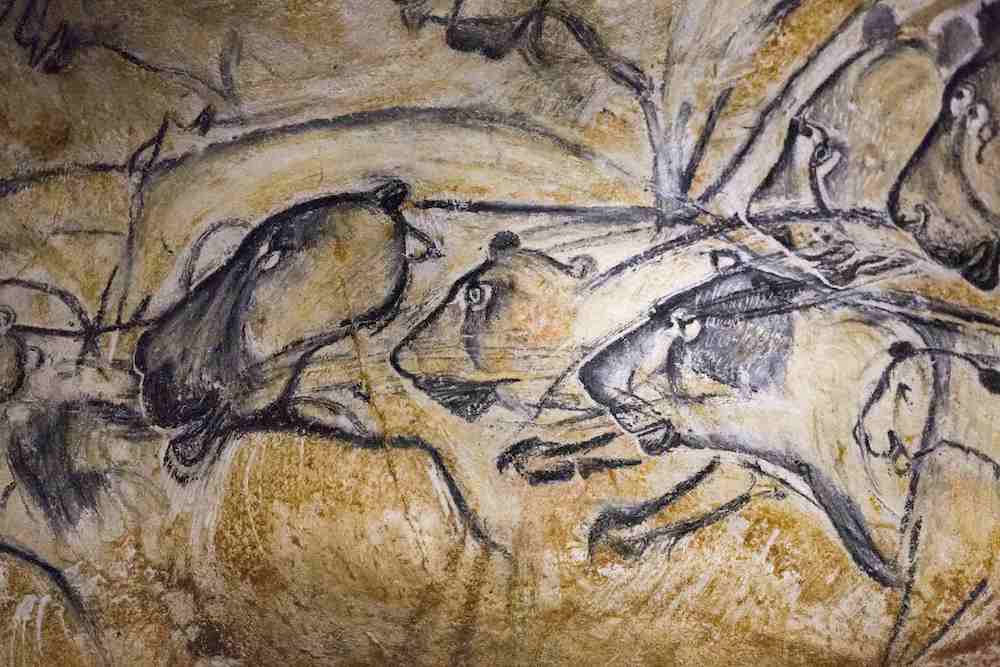
A: multiplayer beauty. The painter was (we presume) deliberately trying to make something that would appeal to his or her fellow cavepeople.
Grand Canyon: single or multiplayer beauty?

A: single-player. Canyons weren't sculpted for our pleasure.
Purebred cat: single or multiplayer beauty?
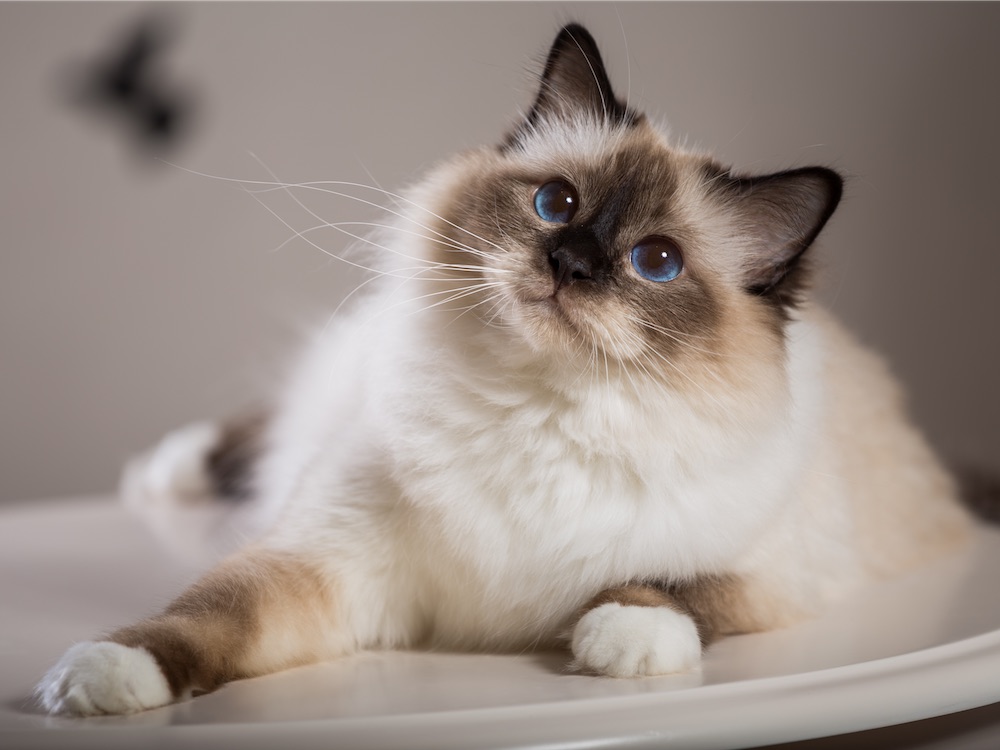
A: multiplayer. Unlike their wild cousins, purebred domestic cats have been selected specifically to appeal to their human owners. In this case, the agent playing Beauty isn’t necessarily the cats themselves (although we could model it that way), but rather the human breeders who are trying deliberately to breed cats that appeal to other humans.
Grapes: single or multiplayer beauty?

A: multiplayer. Fruit wants to be eaten and evolved as a Beauty player purposely to appeal to frugivores (like us).
Carrots: single or multiplayer beauty?

A: hard to say. Carrots are tubers, which traditionally evolved as a strictly functional (single-player) plant organ — a store of energy buried in the ground. If we find them attractive, then it says more about us than about the carrot plant. And in general, vegetables are less intentionally beautiful than fruit. But nowadays vegetables are bred for shelf appeal, and orange carrots in particular were cultivated fairly deliberately, suggesting a multiplayer dynamic.
Crystals: single or multiplayer beauty?

A: another edge case. In their native habitat, crystals arise entirely on their own, without any coupling to a Desire player. But their native habitat is buried deep in a cave, or else locked inside a geode — i.e., out of sight. So when regular people like you and me actually lay eyes on a crystal, it’s typically because someone else — a human Beauty player — went and dug it up, knowing it would appeal to us. In other words: a crystal by itself is just a fluke product of nature, but a crystal found and put on display is, like many acts of curation, a deliberate attempt at beauty.
(In this view, there’s no difference between an artist who makes art and one who finds art. Photography, for example, often undermines this distinction. Is a scene captured on film "made" or "found"? Mu.)
Dandelion head: single or multiplayer beauty?
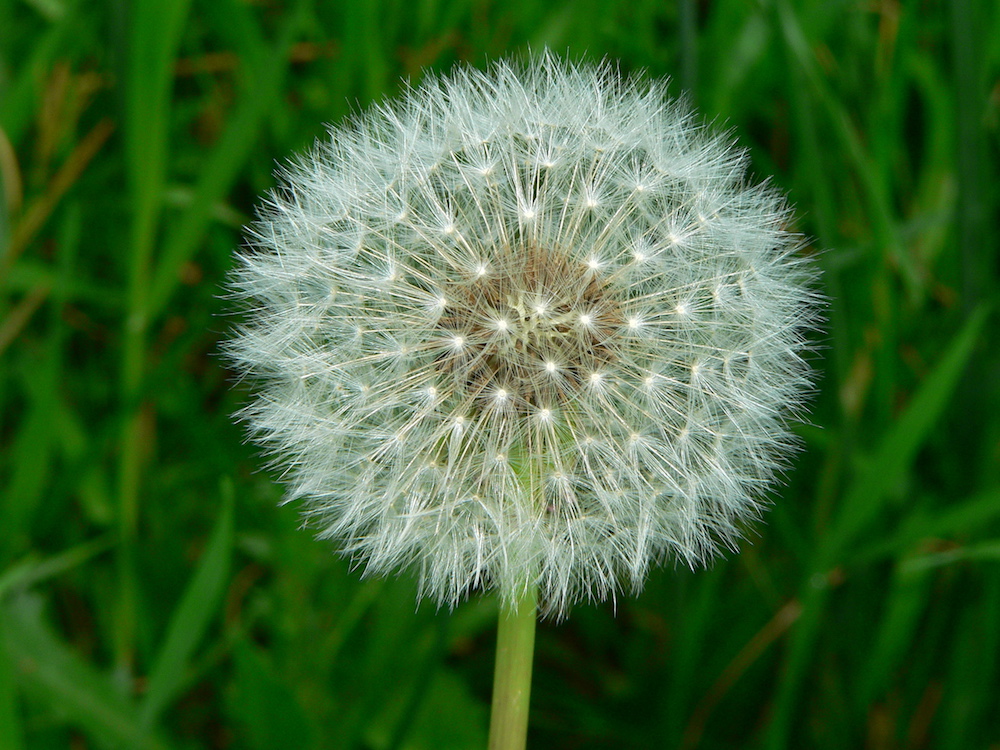
A: neither. The fact that we find this part of a dandelion beautiful is largely a coincidence — a spandrel. Certainly the dandelion head didn’t evolve for us: it’s a device for scattering seeds on the wind, not a lure for us (or any animal) to engage with it. Nor, I think, did we evolve any special eyes for the dandelion. Instead, dandelions give off perceptual cues (like symmetry and repetition of form) that happen to coincide with strategies used by bona fide Beauty players for which we may have coevolved an appreciation.
Note that this shouldn’t in any way tarnish our appreciation of the dandelion. Whatever the underlying cause, it still tickles the beauty centers in our brains. But insofar as we’re calling attention to the game mechanics that underlie beauty, it must be noted that there’s no coupling between our desire circuits and the dandelion form. Neither is chasing the other.
In fact, the same can be said for our relationship to flowers more generally. Flowers are playing multiplayer beauty with pollinators, clearly, but why they happen to appeal to us is a fascinating open question.
OK, last one.
Tree branches and leaves: single or multiplayer beauty?
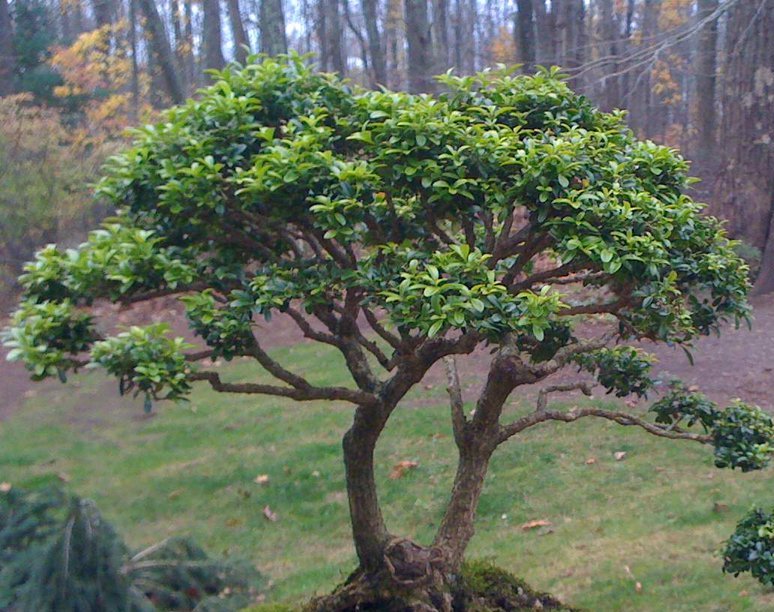
A: It has to be single-player... right? A tree is a strictly functional life form; it’s not trying to appeal to anyone. We often find trees beautiful, but they don’t grow because of us.
But what if a tree is planted deliberately in a garden? Then it starts to seem more like an act of multiplayer beauty — a human making something for other humans to appreciate.
In fact, this tree is a bonsai:

So yeah, definitely multiplayer.
One of the main takeaways here is that the real world is messy, and single- and multiplayer beauty aren’t always easy to distinguish. Often the two mechanics are happening simultaneously, and we can see one or the other depending on which frame or level of analysis we choose to apply. As a final frame-shift, consider approaching the images above as photographs. From that perspective, they’re all products of a multiplayer game (where photographers act as deliberate Beauty players). But these nuances notwithstanding, I maintain that the two mechanics — single- and multiplayer beauty — are analytically distinct, and can (and should) be understood separately.
Alright, thanks for playing. Back to our regular program.
Independent vs. Correlated Desire
Now that we have a handle on beauty as a multiplayer game, I want to illustrate what these concepts are capable of. Specifically, I want to show some of the questions that can arise from this framework.
To that end, let’s compare and contrast a honeybee and a fine art collector. Two very different creatures, and yet both are Desire players in games of multiplayer beauty. Both are attracted, by way of their aesthetic sense, to deliberate Beauty products — flowers in the case of bees, artworks in the case of the collector. And both hope to be rewarded for their pursuit of beauty, whether in nectar or in money/prestige.
That said, bees and art collectors face very different incentives vis-à-vis other Desire players in their respective games.
Specifically, the honeybee gets to make its choice (of which flower to pursue) entirely on its own, without regard for what the other bees are doing. A bee’s only concern is whether a flower has nectar, not whether any other bees are also attracted to it.⁴ In contrast, an art collector must not follow her own instincts in isolation, or she risks investing in something that has no market value. Instead, in the fine art world, it pays to have broadly the same tastes as everyone else (unless you’re buying art for personal consumption, e.g., to hang in your bedroom).
Let’s say that pollination is a game of Independent Desire whereas art collection is a game of Correlated Desire. The distinction is whether the rewards that accrue to a Desire player depend on what the other Desire players are doing. Here again are some cartoons:
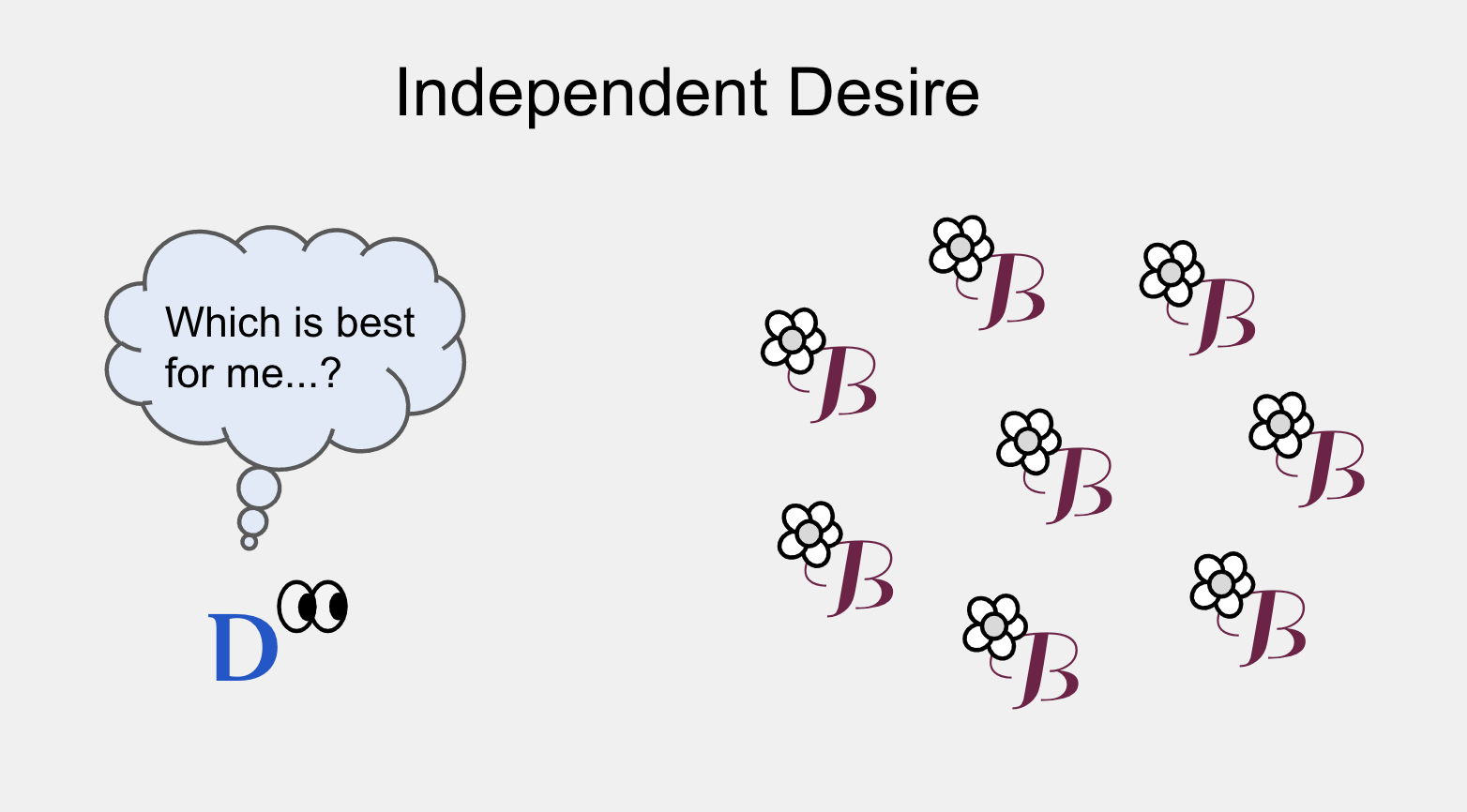
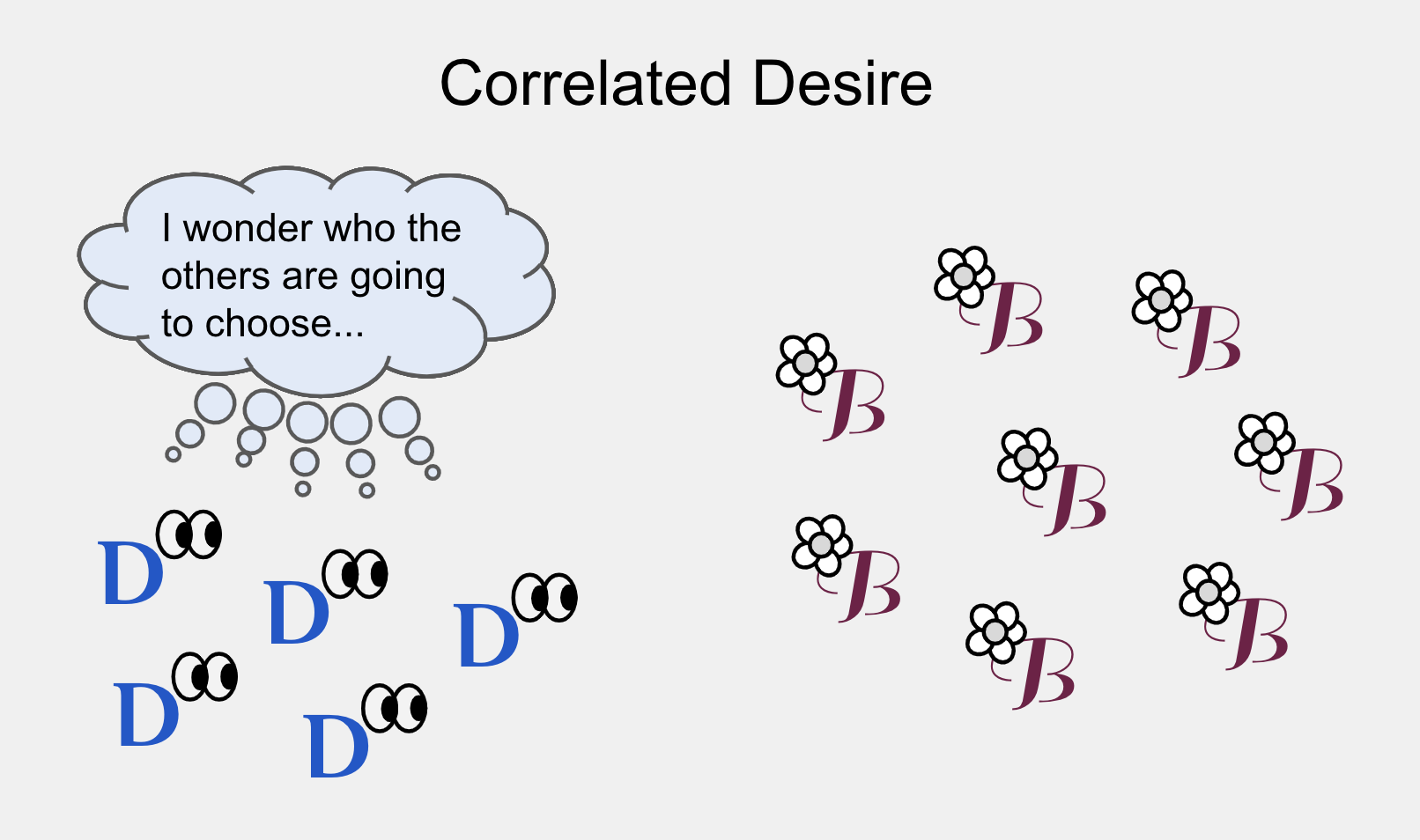
What about sexual selection? Is it driven by Independent or Correlated Desire?
This turns out to be quite the contentious issue, and the literature is split more or less down the middle.
To illustrate the two camps, let’s take the concrete question of why peahens (female Desire players) are attracted to peacocks (male Beauty players):

One story goes like this:
A peacock’s tail serves as an honest signal of his genetic fitness and therefore his quality as a mate. In order to grow something so big and bright and highly-ordered, the peacock must be a hearty specimen with good genes. And thus the benefit to the peahen is fairly straightforward: by choosing a beautiful mate, she’ll tend to have healthier, heartier offspring — who will, in turn, leave her more grandchildren.
In this story, peahens are playing a game of Independent Desire. Each gets to choose the mate she considers the healthiest (i.e., most beautiful), without regard to what her peers are doing.
The other story goes like this:
A peacock’s tail is not an honest signal of his fitness. Whatever heartiness is required to produce the tail is cancelled out by the hassle of lugging it around — so males with small, drab tails are just as good at surviving as males with big, bright ones. Instead, a peahen who desires flashy tails is rewarded because other peahens also desire those tails — and therefore the sons that she makes with her beautiful mate will tend to be desired when it’s their turn to reproduce.
In evolutionary biology, this is called runaway sexual selection. And if it sounds circular, well, that’s because it is. In runaway selection, the initial female desire is entirely arbitrary, but it gets fixed within a population simply because everyone else is doing it. Think of it as a self-reinforcing popularity loop. There may be no reason for the initial popularity, but once bright tails become popular, they can remain popular indefinitely (because any female who mates with an ugly/unpopular mate will have ugly/unpopular sons). This is a game of Correlated Desire.
So then, in the case of peafowl, which is it? Did the peacock’s tail evolve in response to Independent Desire (honest signaling) or Correlated Desire (runaway selection)?
At the risk of being a wet blanket, I suspect it’s a bit of both. So instead of trying to adjudicate, I’d like to make some general remarks about how to determine which type of game is being played, Independent or Correlated Desire.
On the Desire side, games of Correlated Desire reward herdthink. In sexual selection, we see this as mate choice copying, where females watch other females to see which males they choose, then copy the most popular choices.⁵ In the human realm, herdthink shows up as mimetic desire, where people want things largely because other people want them as well.⁶
But what about the Beauty side? Do the forms of beauty that evolve in the two types of games differ in systematic ways? Perhaps, although I don’t know how strong the effect is. In games of Independent Desire, beauty solves a concrete problem: how to induce a Desire player into a relationship with a Beauty player. And thus there are constraints on the forms that such beauty can take. For example, a flower has to be bright and stand out from the background in order for pollinators to see it from afar. However, in games of Correlated Desire, the objects desired by the herd can take on more arbitrary forms, resulting in a kind of hollow or degenerate beauty — things that are desired only because everyone else desires them (or is thought to desire them), rather than for their intrinsic qualities. (See for example much of contemporary art and architecture.) In these cases, beauty can persist because of the network effect (self-reinforcing popularity), but there’s nevertheless something fragile about it. Biology nerds may recognize this as the lek paradox, while economists will see some of the problems with fiat currencies (e.g., that governments often have to prop them up by artificial means). In both domains, the desire will be more stable if the object in question has even a touch of intrinsic value: gene quality in the case of sexually-selected ornaments; rare metals in the case of money.
Beauty and goodness
Here’s an interesting question (the last one we'll consider today): Is a Venus flytrap beautiful?
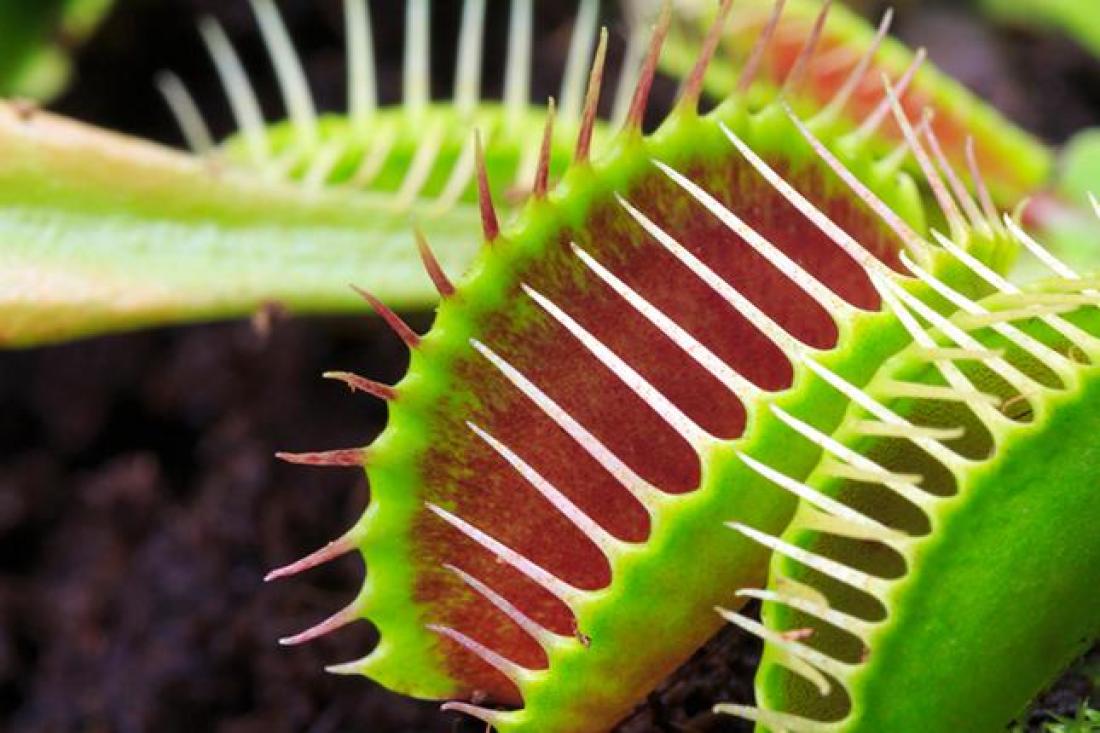
I don’t mean beautiful to us, but rather to the insects it eats. Is the flytrap using beauty to attract its prey?
Or what about the sundew (another carnivorous plant)?
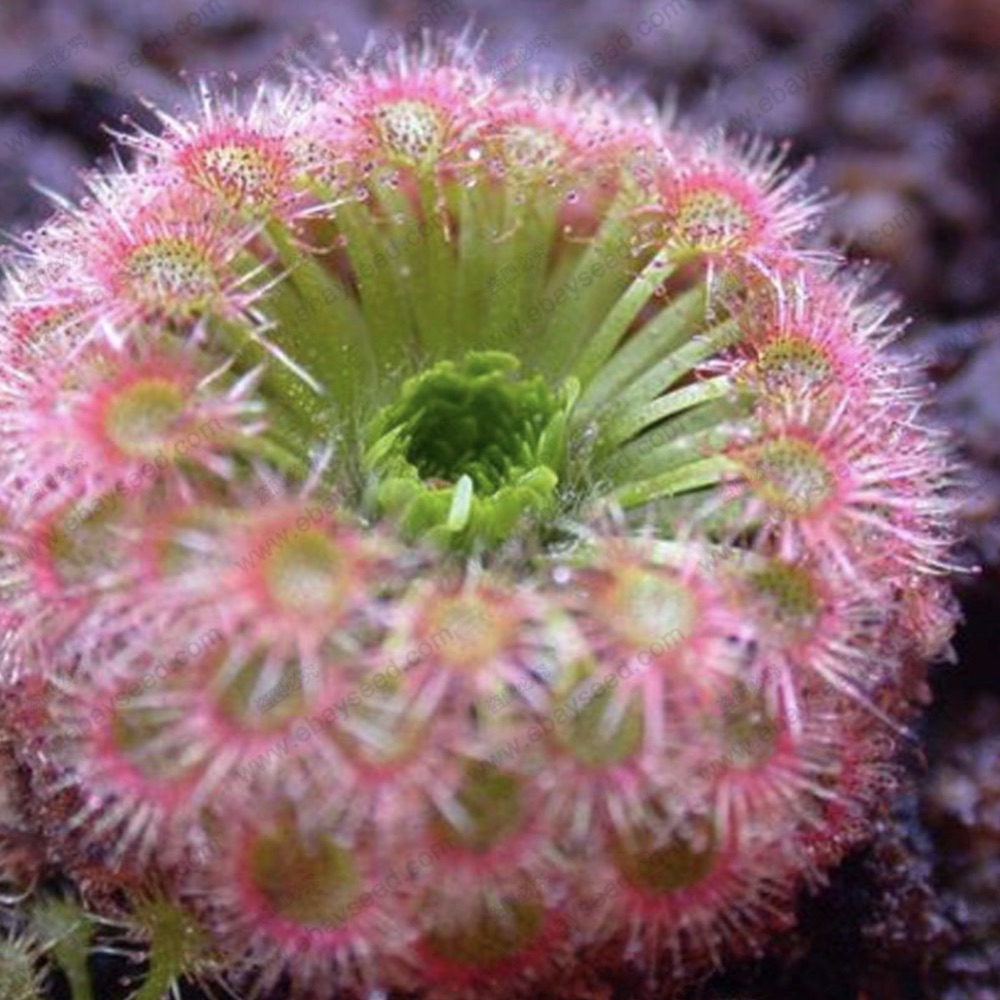
There are nuances here, but I’m going to argue that carnivorous plants don’t — in fact, can’t — use beauty to attract their prey.
To understand why, consider again the flower and the honeybee. The flower is playing an iterated, positive-sum game with the bee, and beauty is crucial to the relationship. Specifically, the flower wants to stand out, because having bold colors and a distinctive shape makes it easier for the bee to find it — to remember that the flower was a good collaborator in the past and to recognize it later down the road.
Now think about the flytrap. In contrast to the flower, it’s decidedly not playing a positive-sum game with the insects that visit it. So the more it stands out, the easier it will be for insects to learn to avoid it — the very opposite of what it wants. And thus it doesn’t benefit from calling visual attention to itself, from being beautiful.⁷
More generally, predators and prey exist in the wrong game-theoretical relationship, i.e., one of exploitation. This is not conducive to beauty. Instead, beauty arises from a collaboration between a Beauty player and a Desire player.
Fun fact: many carnivorous plants also make flowers. But note that they take pains to keep their two activities separate. Their flowers look nothing like their mouths, and they hoist the flowers high up off the ground (away from their sticky parts) so their pollinators won’t accidentally get eaten. Like any agent interested in sustained collaboration, they learn not to prey on their partners:
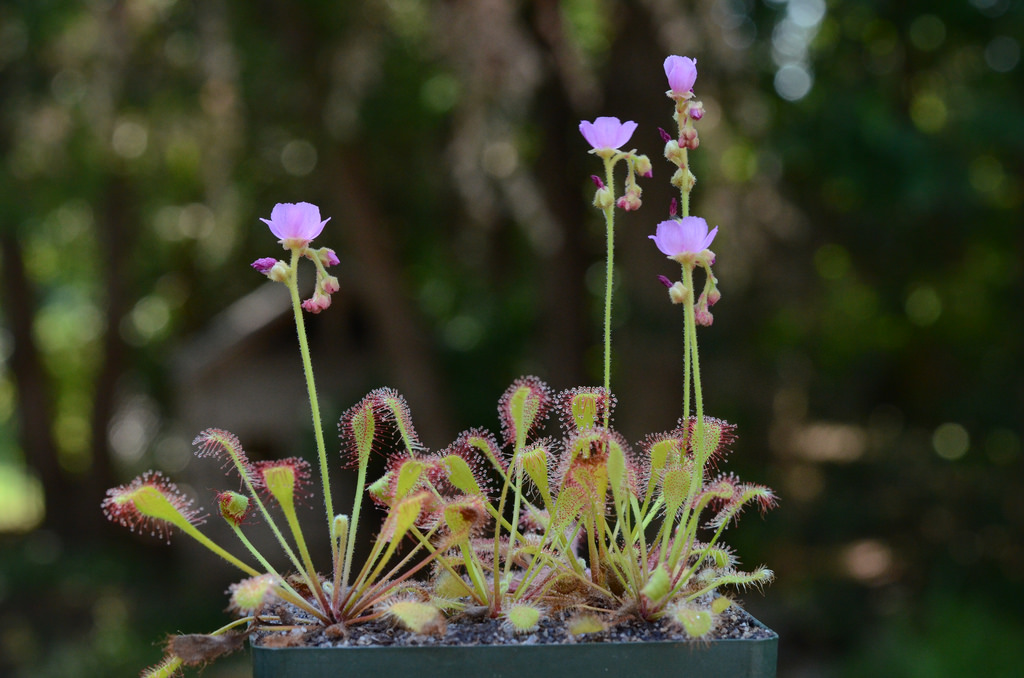
If this analysis generalizes — and I think it does — the conclusion is startling: Beauty is typically good. More precisely, the Beauty role works best for agents pursuing win-win interactions with Desire players.⁸ Agents with “bad” intentions (those who intend to hurt the Desire players) generally don’t benefit from investing in beauty and calling attention to themselves. Instead they try to hide and blend in.
The main exception to this rule, and it’s a significant one, is the existence of mimics and counterfeits. These players — we might consider them a third player type, the Cheat — copy the distinctive forms worked out by honest Beauty players in their pursuit of Desire. But whereas an honest Beauty player somehow provides a benefit to the Desire player, the Cheat does not. For example, one orchid species masquerades as a bellflower — but only the bellflower rewards its pollinators with nectar. The orchid just mooches off of their productive relationship.
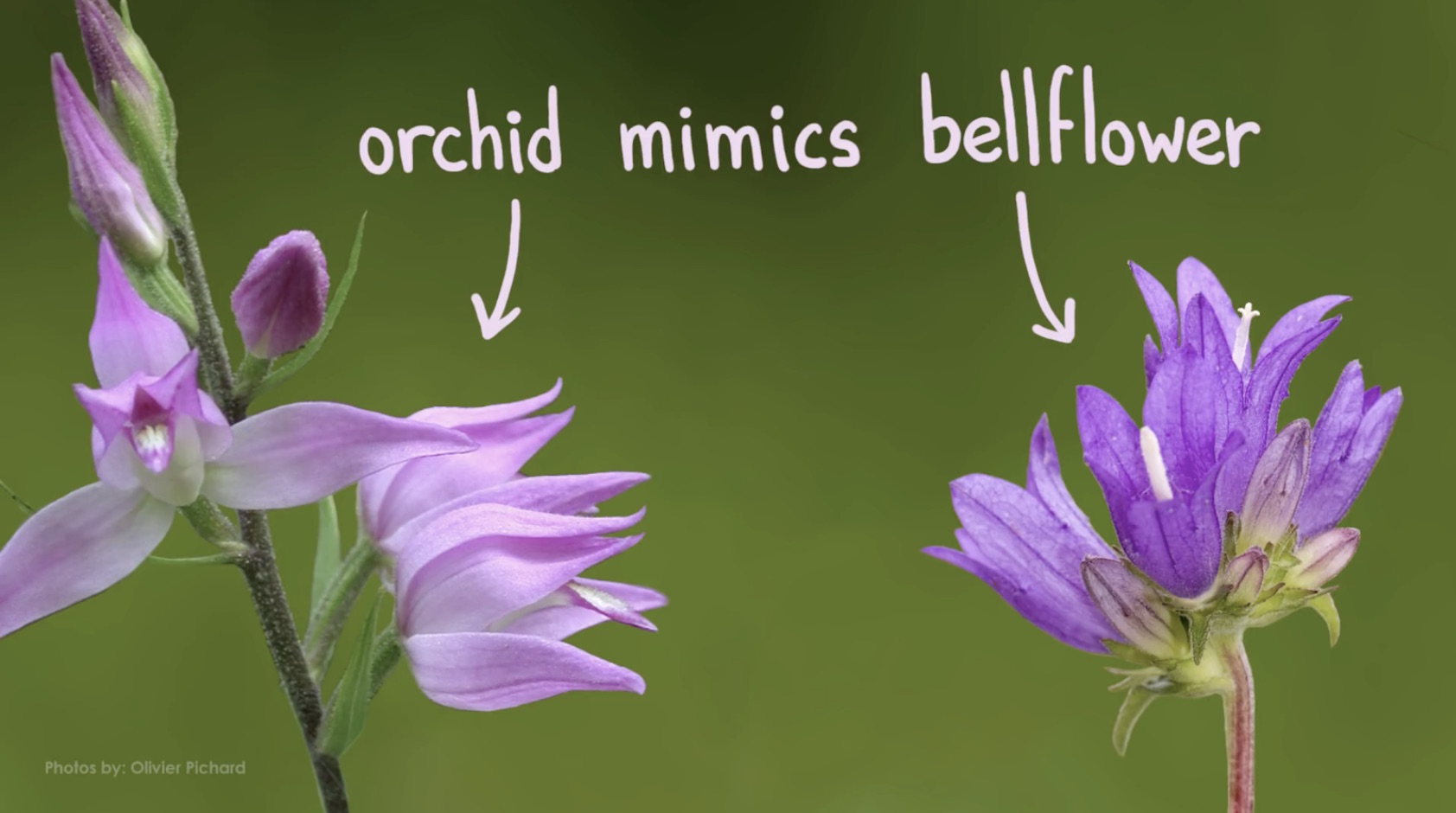
In general, though, cheaters can only exist in a world paved by honest players, and the extent to which they can cheat is limited by the success of the strategy they exploit. Without the bellflower to reinforce pollinators, the orchid would have nothing to gain by making a nectar-free flower. And when mimicry becomes too easy, the entire niche collapses, cheats and honest players alike. And thus, in the limit, beauty tends to be good.
Wrapping up
Well there’s a lot more to say, but I’ve gone on long enough.
For those of you interested in exploring further, I’ve left some threads to pull on in the addendum below (“To ponder”). For everyone else, I hope I’ve demoed how to approach beauty as an ecological phenomenon. It’s not about debating whether a given object is or isn’t beautiful. Nor is the goal to identify the Platonic essence of beauty. Instead, it’s about exploring the ecologies in which beauty grows.

___
Thanks to Nick Barr, John Nerst, and Charles Feng for feedback on a draft of this essay, and to Forrest Bennett and Diana Huang for some great conversations about beauty.
To ponder
I don’t know the answers to these questions, but they seem worth thinking about:
- What explains the common strategies used by Beauty players in their production of beauty? E.g., clean lines, smooth surfaces, symmetry, repetition of forms, intricacy, elaboration, rich colors, strong contrasts. Are there underlying principles here? In particular, I'm intrigued by the idea of beauty products as proofs-of-work.
- Why are flowers, which evolved to attract insects and other small animals, so attractive to us? Why do we find flowers beautiful? Three possible answers: (1) Coincidence. (2) “Standing out” is the main factor, and both pollinators and humans appreciate when something stands out. (3) Both pollinators and humans use similar standards for evaluating proofs-of-work, because these standards are somewhat universal. Of these, (3) is the most interesting, but I can’t rule out (1) or (2).
- What happens when you introduce Desire players with an appetite for novelty? How does that change the gameplay?
- Are deep sea creatures objectively uglier than their shallow-water counterparts?
- Why are desserts, relative to main courses, more often a vehicle for beauty? (I’m not sure there’s a good answer here, but it seems tantalizing.)
- Why does it feel morally wrong to see beauty emerging from evil places, like the architecture and pageantry of the Third Reich?
- How do the different sensory modalities influence how beauty is expressed in them? In particular, sight, sound, and smell can operate at a distance, whereas taste and touch can only operate up close. For a game based on attraction, this seems relevant. C.f. Denis Dutton’s remark: “Beauty is nature’s way of acting at a distance.”
Endnotes
¹ Bees are actually one of the more generalist pollinators, visiting many different flower species. But at any given time (e.g., during a foraging session), they tend to specialize.
² I couldn’t find a direct estimate of angiosperm biomass, but this paper argues that terrestrial plants account for 80 percent of Earth’s biomass, and a number of sources (e.g., here, here) suggest that angiosperms dominate within the plant kingdom.
³ Caveat: these activities could be a way to learn, for the ultimate purpose of attracting a member of the opposite sex. There’s a lot of precedent for this among birds.
⁴ In fact, the bee might prefer to have desires that are anti-correlated to the desires of other bees, to avoid competition. Thus the more general formulation of this distinction is that Desire players can experience either a positive or negative network effect from other Desire players. And when the sign is negative (as in pollination), Desire players experience crowding and therefore incentives to speciation. This is one reason angiosperms have radiated more than any other clade of plants.
⁵ It’s not that we would never see copying in a game of Independent Desire. For example, younger females (who have underdeveloped tastes) might watch older females (with better-developed tastes) in order to learn from them. But all else being equal, if the game is one of Correlated Desire, we should expect more copying among the Desire players.
⁶ I’m using Girard’s term here, but to be honest I’m not sure if his analysis of it lines up with mine.
⁷ Perhaps this helps explain why flytraps, despite their name, don’t particularly prey on flying insects. Animals who roam the air have too many choices, too much freedom. Instead, flytraps mostly prey on crawling insects, a category that, in one estimate, accounts for 95 percent of their diet. These are land-based creatures who (relative to their winged counterparts) don’t do as much steering with their eyes, who just kind of grope around until they accidentally stumble into the wrong place.
⁸ This is actually an instance of a much more general rule, namely, that signals can only evolve (as a stable feature) when there’s an overlap of interest between sender and receiver.
Photo credits
Most were blatantly copied from random Google image searches. The two I remember are: (1) blue sky (Alex Machado), (2) orchid/bellflower (Olivier Pichard via MinuteEarth).
 Melting Asphalt
Melting Asphalt
